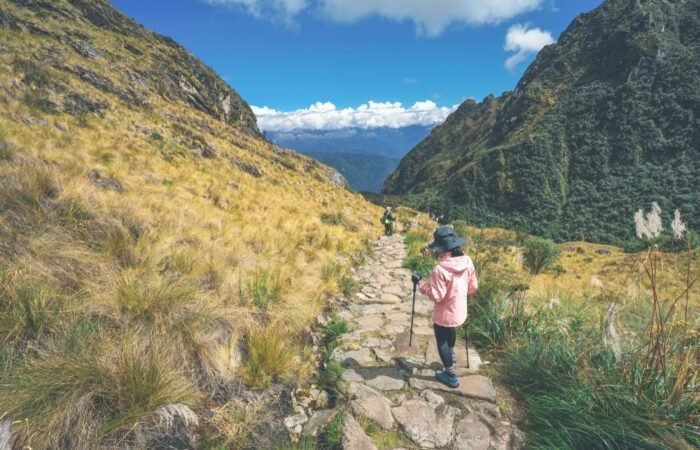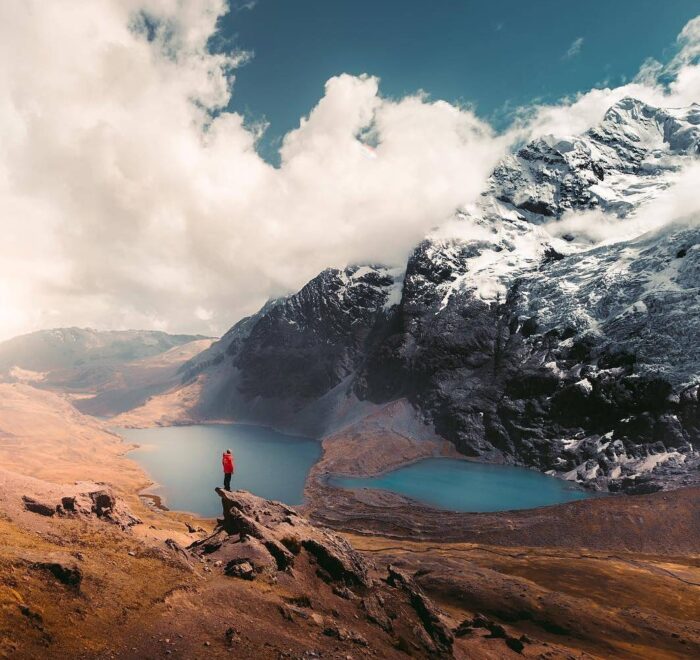


Whether you’ve already booked your vacation to Peru or are still planning the logistics, you’ll be putting together an itinerary. One fantastic option that not many tourists get to enjoy is the Ausangate Trek.
The Ausangate glacier can be seen from the city of Cusco and is the highest peak in the region. Venturing on this route will reward you with stunning views of snowy mountains, crystalline lagoons, and lots of flora and fauna unique to the area.
If there’s one thing that can slightly ruin your experience, it’s bad weather. If you know what to expect, you can avoid the rainy season or at least know that it’s likely to occur during the wet months.
In this guide, you’ll discover what the weather’s like during every month of the year at Ausangate, when’s best to visit, what to pack, and more.
Whether you’ve already booked your vacation to Peru or are still planning the logistics, you’ll be putting together an itinerary. One fantastic option that not many tourists get to enjoy is the Ausangate Trek.
The Ausangate glacier can be seen from the city of Cusco and is the highest peak in the region. Venturing on this route will reward you with stunning views of snowy mountains, crystalline lagoons, and lots of flora and fauna unique to the area.
If there’s one thing that can slightly ruin your experience, it’s bad weather. If you know what to expect, you can avoid the rainy season or at least know that it’s likely to occur during the wet months.
In this guide, you’ll discover what the weather’s like during every month of the year at Ausangate, when’s best to visit, what to pack, and more.
There’s no one month that’s better than all the rest, but certain times of year trump the others. June and July are usually the most popular months for tours in Cusco due to the fact that it’s the middle of the dry season. There are also many festivities in the city this time of year.
However, the nights are also the coldest this time of year, so you might want to reconsider. May, September, and October are the best three months to avoid the freezing nights and also (hopefully) avoid the rain.
Below, we take a closer look at how the climate and weather change each month during the wet and dry seasons.
At the beginning of November, the landscape looks pretty dry because it hasn’t been raining for quite a few months. During this month, the showers will begin, although they’ll be a little sporadic and won’t happen every day. The temperature is relatively warm in the day with quite cold nights.
In the Cusco region, this is the start of summer. But remember, at Ausangate, you’re at a very high altitude and among the glaciers, so don’t expect it to get too hot. If the day is dry, you’ll feel warm in the sun. However, this is when the real downpours start, too. You’ll still be able to travel, though. Just take waterproofs, and you’ll be fine.
You might not see the sun so much this month as dark clouds are frequent in the skies. The amount of rainfall is increasing, but there’ll still be breaks in the cloud for the sun to shine through, which warms the area quickly. Heavier rainfall will make things a little colder overall this month.
Rainfall is still getting heavier in February, and during this month, a lot of the other trekking routes are closed, including the Inca Trail. This is because trails can get slippery, and they also carry out maintenance. If you decide to trek this month, you’ll find the climate rather cold due to showers and the sky quite cloudy. Make sure you’re prepared with plenty of rain gear and boots with a good grip.
This month is usually when it rains most during the entire year, so pack accordingly. The climate gets a little warmer in March. Be warned that the trail might still be slippery from all the showers.
Luckily, we’re coming to the end of the wet season now, and there’s a dramatic decrease in the amount of rainfall. However, the odd shower will still occur, which is why this month is included in the rainy season. Skies will be clearer to enjoy spectacular views, and during the day, you’ll be warm.
The dry season brings with it plenty of sun and clear skies. You’re guaranteed some incredible views of the glistening snowy landscapes and crystalline lagoons. This does, however, draw more crowds to Cusco. But, as we’ve mentioned already, this trek is never overrun. To secure your spot, it’s always a good idea to book a bit in advance during this time of year.
At last, May marks the official beginning of the dry season in the Cusco region. Don’t be surprised if you still see a shower or two, but precipitation drops much lower than in previous months. Nights will still be cold, as they always are high up in the snowy mountains, but during the day, you should feel the warmth of the sun. We recommend this month to visit Cusco, as the big crowds don’t arrive quite yet.
This is the driest month of the year, and you’ll likely not see any rain. It’s also when tourist season really picks up, but you can avoid crowds on this off-the-beaten-path route. The nights are getting much colder, and you’ll need a high-quality sleeping bag to stay warm until morning. In the day, the sun will be strong.
Brrrr. This is the coldest time of the whole year, and the nights go well below 0°C. This doesn’t mean you’ll be chilly all day. The sun warms things up for the afternoon and is very strong—make sure you stay well-protected. July is usually very dry, but don’t be surprised by the occasional hailstorm.
Winter is coming to a close, but nights are still very cold. The days are getting warmer, and this month is known for being very windy. Rainfall is low, and you should experience some outstanding views of the Andean landscapes.
The nights aren’t quite as cold now, and you can expect the days to be beautiful with clear, sunny skies and warm temperatures. You might experience the odd shower here and there, but nothing major.
This is the warmest month of the year, and the weather is often clear and very pleasant. However, with the rainy season approaching, you’re a little more likely to get wet. This is the last month of the year to get the best views of the mountains.
The coldest months of the year are June and July. These two are bang in the middle of the dry season, but the nights get extremely cold. If you venture out to trek in Ausangate during this time of year, you’ll need a warm sleeping bag and plenty of clothes for the evenings. However, you can still expect the days to be bright and warm when in the sun.
You can’t fly directly to Ausangate. Instead, you have to fly into the city of Cusco. Flights generally run on time and don’t face any issues. However, during the rainy season, it occasionally rains very heavily, which can cause delays or canceled flights. Keep this in mind when traveling at this time of year.
As you can see, the climate can get pretty cold at this altitude, and you’ll need to ensure you stay warm at all times. You’ll also need to protect yourself from the sun as you’re much closer to the UV rays. We recommend the following when trekking to Ausangate:
Now you understand the different seasons, and when to avoid the rain, it’s time to start planning your trip. Don’t forget to consider the rain and when it’s colder.
Also, please make use of our in-depth packing list to ensure you have every last essential needed for the trek to this incredible glacier in Cusco.
Enjoy your time in Ausangate!
Ausangate trek is one of the most beautiful circuits to explore with impressive views and landscapes.